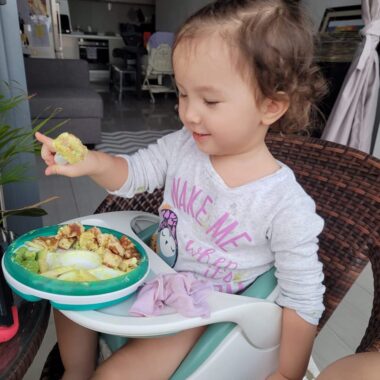An online workshop on speech therapy speaks to parents’ needs
Noting his daughter's success at talking, a columnist shares his methods

We prepared each meal with diligent slicing, dicing, and pureeing. Each menu and food item was selected thoughtfully for its necessary nutrition. With each spoonful of food, however, anxiety filled our hearts that this one might send our daughter, Rylae-Ann, back to the emergency room.
My wife and I did our best to avoid a stomach port or feeding tube because we knew that feeding was a precursor to speech — but we also knew children with aromatic l-amino acid decarboxylase (AADC) deficiency have difficulty swallowing, among many other challenging symptoms. Still, we wanted to do our best to support speech, which to us meant our daughter needed oral feeding.
If a parent faces this decision, I understand opting for a different direction. Rylae-Ann was sent to the emergency room several times because of aspiration. We almost lost her.
At first, we didn’t understand why she kept aspirating. We were so careful, so meticulous. Yet somehow, she kept getting fluid in her lungs. We later learned how to improve feeding, reduce aspiration, and provide adequate sleep. With those tasks successfully established, we could focus on speech therapy.
Speech therapy
When my wife, Judy, began speech therapy with Rylae-Ann, we were unsure what would be possible. We knew that our daughter had great potential after receiving gene therapy, but we weren’t certain what the medicine’s results would be.
Initially, we set the end goal for my daughter to communicate for herself through basic yes or no answers. If she could one day say “I love you,” it’d be a fantastic present. But today, with daily intervention, our 5-year-old daughter can read, write, speak, and listen in English. She can also read and speak in Chinese and knows some basic Thai words.
This success was all a result of speech therapy, which is why we added it to our Teach RARE Caregiver Lifestyle Series, an online parent meetup where professionals discuss how to embed therapy strategies at home. We conclude each event with a question-and-answer series. Our physical therapy and occupational therapy events had great turnouts, but our speech therapy had the highest attendance yet.

After combining occupational therapy and speech therapy, Rylae-Ann has learned to eat by herself and talk. (Photo by Richard E. Poulin III)
Caregiver online event
Nearly 100 rare disease parents joined our speech therapy event on May 21. We had Ming Fung, the founder of Agents of Speech and a professional speech therapist who helped us in our journey, to host the event.
We found Ming online while living in Singapore. We’d been searching for ways to improve our daughter’s speech, but could not find any therapist willing to treat her. Most thought she was too young or that her case was too complicated.
Ming’s mission and vision aligned with what we wanted as parents. Our daughter showed significant improvements with his training. The other important fact was that Ming had experience with oral placement therapy, a proactive speech therapy approach that believes in early intervention. As educators, my wife and I knew this approach would deliver the best results.

An older student supports Rylae-Ann in reading aloud during a peer learning activity at school. (Photo by Richard E. Poulin III)
Highlights from the speech therapy event
Ming opened the event by discussing his journey and reviewing our daughter’s case. He described how our questions and concerns at the time were nearly identical to those of other parents he works with. Everyone wants to know what parents can do to help improve their child’s speech despite their rare disease.
The event highlighted these four considerations:
- Identify a child’s risk factors and speech challenges. Knowing these will allow you to create an individualized treatment plan.
- Develop speech goals. You can apply the “Understanding by Design” framework to use backward planning to establish your end goals, then create smaller milestones leading to the larger goal. It’s best to do this planning with a licensed speech-language pathologist.
- Create a therapy schedule, which will prime your child’s brain for learning. Consider the available time; it’ll motivate you to commit daily.
- Create internal motivation within your child. Yelling, demanding, or even using candies don’t work as well as positive praise, high-fives, or clapping. If the goal is too difficult, adjust — because too much frustration is counterproductive.
Speech therapy approaches
During the question-and-answer session, the topic that got the most discussion was which approach was best. For our daughter, it was oral placement therapy and play-based learning. However, there are several others to choose from.
One approach is not necessarily best or better than another, but you may find an approach that better suits your child’s needs or aligns with your abilities. Consider learning different techniques, though. The novelty of varying activities creates motivation and deeper learning.
Don’t fall victim to any misleading ads that claim to have the guaranteed secret that’ll get your kid to start talking. We fell victim because we so dearly wanted our daughter to talk. However, we all made terrific accomplishments by working as a family and supporting one another on the journey.
Note: AADC News is strictly a news and information website about the disease. It does not provide medical advice, diagnosis, or treatment. This content is not intended to be a substitute for professional medical advice, diagnosis, or treatment. Always seek the advice of your physician or other qualified health provider with any questions you may have regarding a medical condition. Never disregard professional medical advice or delay in seeking it because of something you have read on this website. The opinions expressed in this column are not those of AADC News or its parent company, BioNews, and are intended to spark discussion about issues pertaining to aromatic l-amino acid decarboxylase deficiency.






Comments